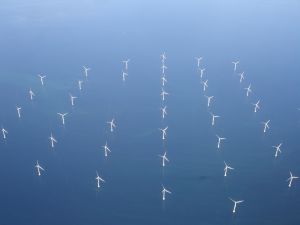In 2015 alone, more than 500 offshore wind turbines were connected to the grid in Germany. So far, mutual interactions of wind parks and their potential effects on local climate have been approximated with models only. Thanks to their wide installation, however, it is now possible for the first time to study their effects in reality: Wind parks are in the focus of the research project “WIPAFF – Wind Park Far Field” that is coordinated by climate researchers of Karlsruhe Institute of Technology (KIT) and executed in cooperation with science and industry partners. The results are to make a further increase in the use of wind power in the North Sea as efficient and environmentally compatible as possible.
On the relatively smooth surface of the sea, offshore wind parks represent obstacles for the wind: The turbines slow the wind down. Turbulences increase. “Depending on the weather, i.e. on wind direction, air temperature, and properties of the water surface, wind speed sometimes reaches its original value after ten to 100 km only,” project head Professor Stefan Emeis of the Atmospheric Environmental Research Division of the KIT’s Institute of Meteorology and Climate Research (IMK-IFU) says. In addition, air masses may be deflected to the sides around large wind parks or upwards. “This may cause the wind parks to shade each other. We also cannot exclude that the climate is changed locally and that temperature, cloud, and precipitation distributions over the North Sea and adjacent coast areas are changed.”

Wind parks may cause air flow to be deflected upwards: If the air cools down, increased cloud and precipitation formation may occur. (Graphics: Stefan Emeis, KIT)
Studies downstream of offshore wind parks in the North Sea, where wind speed is reduced, are in the focus of the research project WIPAFF funded by the Federal Ministry for Economic Affairs and Energy with about EUR 1.75 million for the next three years. The project partners of KIT are Technische Universität Braunschweig, the University of Tübingen, Helmholtz-Zentrum Geesthacht (Center for Materials and Costal Research), and UL International GmbH (former DEWI, German Wind Energy Institute). The scientists will use a number of different methods. For example, they will combine instruments on platforms in the North Sea and instruments on a research aircraft with the evaluation of satellite data for the detailed determination of the wind field, weather conditions, and waves on the surface of the sea upstream and downstream of wind parks.
It is the objective of the KIT researchers to model the wind field between ten and 100 km downstream of large wind parks. For this purpose, they adapt an existing numerical wind field model (WRF) to the sea conditions in the North Sea. “Such a wind field model can be compared with a weather forecast model. Normally, the roughness of the sea surface is given as a function of wind speed in the wind field models. We want to calculate the waves with a wave model and determine the roughness of the sea surface more precisely on this basis in order to come closer to reality,” Stefan Emeis, IMK-IFU, explains. In addition, he and his team add a description (parameterization) for large wind parks, which is based on the output of the park and the height of the turbines. Parameterization indicates how much energy is extracted by a wind park from air flow at which height above the sea surface. With this extended model, the platform, aircraft, and satellite measurements evaluated by the project partners can be reproduced and complemented. In subsequent scenario calculations, the scientists then calculate the impacts of extension stages of wind parks in the North Sea on wind conditions and, hence, on local and regional climate. “An effect may be that wind parks slow down air flow and force it upwards. When ascending, air cools down. This may cause increased cloud formation and partly even precipitation,” Stefan Emeis says.
More about the KIT Climate and Environment Center: http://www.klima-umwelt.kit.edu/english.
In close partnership with society, KIT develops solutions for urgent challenges – from climate change, energy transition and sustainable use of natural resources to artificial intelligence, sovereignty and an aging population. As The University in the Helmholtz Association, KIT unites scientific excellence from insight to application-driven research under one roof – and is thus in a unique position to drive this transformation. As a University of Excellence, KIT offers its more than 10,000 employees and 22,800 students outstanding opportunities to shape a sustainable and resilient future. KIT – Science for Impact.

